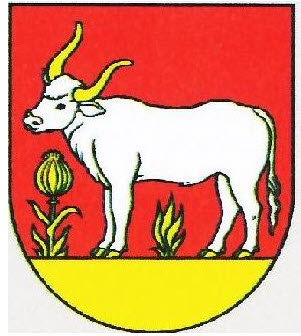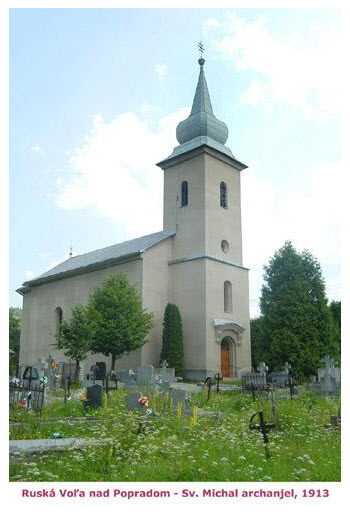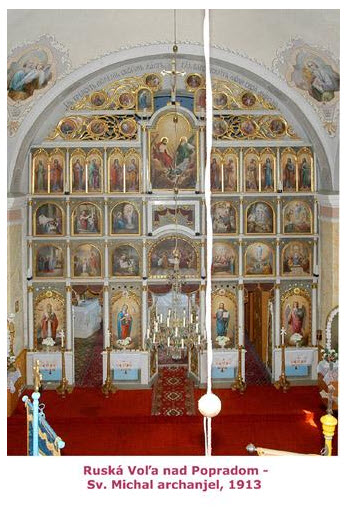
The first mention of Ruska Vol’a nad Popradom in historical records is found in the year 1588. The village was acquired by Juraj Horvat, owner of the Plavec estate which owned other villages in the surrounding region. The village did exist before the year 1588, it is estimated it began in 1580. The original name Voľa confirms this village was established with residents.
The villagers paid taxes during the year 1600 and there were 7 homes. The residents were mostly farmers who worked as shepherds and wood cutters. In 1636 the residents of the village were considered owners of small portions of land. During 1718 11 families relocated to Poland. During 1787 there were 12 homes and during 1828 it had expanded to 33 homes. In the 19th century the Bornemis and Dezofi families had their estates in this area. On the estates were farmers, cattle raisers and those who worked in the forests. Some residents from the village were employed on the estates. After the First World War the economic situation of the village was depressed and work was limited. During World War II residents of the village gave aide to Polish refugees and protected illegal workers and guerilla groups operating in the vicinity against the German Army.
The village was liberated on January 21, 1945, four months before the Second World War ended. After liberation, a communist government was installed. However, voting was not unanimous for the communists. The 1946 elections had 149 votes for the communists, 73 votes for the Democratic Party, 24 votes for the Labor Party and 2 votes for the Freedom Party. During 1947 5 families were relocated to Soviet Russia. A public cooperative farm was established in 1950, however, it ceased functioning not long after it was started. It was reestablished in 1958 but never operated efficiently. On August 5, 1950 a serious hail storm hit the village and destroyed crops and badly damaged homes. In 1954 the construction of a new state roadway, L’ubotin-Lenartov was begun. During 1959 electricity was installed in the village and public lighting and a local radio station began operation. In 1959 the village cooperative farm was transferred to Lipany, then Stara Lubovna. Eventually, the collective was taken over by the village of Circ. In 1964 the forests surrounding the village were severely damaged and this added to the decline of the local economy.
A municipal council building was constructed in 1965. Roads were paved and a regional water supply system was installed in 1983. Also, during this period tennis courts and new residential homes were built. In 1986 a physical education club was founded, Slovan Russka Vol’a na Popradom, which included football and table tennis clubs. The village population has declined in recent years on a continuous basis.
Over time there have been varying names for the village:
1588 Nowawolya, Volya, 1635 Volya, noviter sicata, 1773 Ruska Wolya, Orosz-Volya, 1786 Orosz Wolya, 1808 Orosz-Alsó-Vólya et Orosz Felso-Volya, Ruská Wola, 1863 Oroszvolya, 1907 Poprádokros, 1920 Ruská Voľa, 1960 Ruská Voľa nad Popradom, in Hungarian, the village was called Poprádokros.
Village Size:
The village lies near the Poprad River at an altitude of 515 meters and covers an area of 6.023 km.
Church:


Photos Provided by, The Greek Catholic Archbishop of Presov
The Greek Catholic Church of Saint Michael the Archangel was constructed from 1916 through 1919 and then re-built in 1952. The church was constructed of wood until at least 1913. It is a light colored single column church with a light green cupola. There is a miniature cupola with a cross over the altar roof and a round window behind the altar. The church is administered by the priest in Circ which at present is Father Jan Makaj. The interior of the church has a stunning six tier iconostasis and the top panel has a large mural of God the Father, God the Son and the Holy Spirit which is magnificent. The altar has a tabernacle with a scene of Jesus Christ at the Last Supper that has a two bar cross on top of it. Behind the altar is a large painting of Saint Michael the Archangel slaying Satan. The church has one crystal chandelier that hangs from the ceiling in the middle of the church. An item of great interest is their gospel book. This gospel has been utilized since 1899 but was published in 1891. What makes this gospel so interesting is in the book of Matthew, from pages 1 to 55, a record is written on each page denoting the name of the person, the dates, and for what reason this gospel book was donated to the "Ruskovoľanská" Church.
In the surrounding area are three chapels, one dedicated to Saint John the Baptist (1770), the Holy Trinity (1875) and the Assumption of the Blessed Virgin Mary (1898.) The church cemetery is located to the left side of the church and has monuments of both concrete and iron crosses. There is also a Jewish cemetery nearby. In 1942 there were 3 families (16 people) who were Jewish in the village. During World War II, all of these families were forcibly taken to concentration camps. None ever returned. The Jewish Cemetery has a number of monuments and the cemetery itself is maintained.
Population:
1878, 114, 1828, 260, 1869, 293, 1880, 236, 1890, 235, 1900, 179, 1910, 208, 1921, 188, 1930, 216, 1940, 227, 1948, 191, 1961, 207, 1970, 205, 1980, 183, 1991, 123, 2016, 101 and 2018, 90 residents. A census taken in 2011 offered 45 residents identified as Slovak, 52 as Ruthenian, 1 as Ukrainian and 1 no identification. According to the same census, 10 residents identified as Roman Catholic, 82 as Greek Catholic and 1 as Evangelical (Lutheran.)



